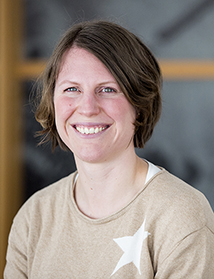Increased knowledge of the vibration transfer process for better adapted and less costly construction works
Fanny Deckner’s doctoral thesis aims to clarify the vibration transfer process to minimise vibrations and predict vibration levels prior to construction.
She has developed an instrumentation system and a numerical model to be able to monitor vibrations and account for the vibration losses in the sheet pile and in the soil simultaneously. Now she wants to implement her research results and continue her research in close cooperation with the construction industry.
What is the topic of your Doctoral Thesis?

I have looked into vibrations that are induced in the surrounding ground when sheet piles are driven by vibratory driving. Sheet piles are used as retaining walls when the ground conditions and/or the lack of space preclude traditional excavation with slopes. The most common, and in many ways most favorable, way of installing these sheet piles is to use a vibrator that is attached to the top of the piles. However, this installation method gives rise to vibrations in the ground, which could harm structures or cause disturbance.
Why did you choose this topic?
Within the construction industry, vibrations caused by pile and sheet pile driving have been a problem for several decades. There has been a lack of knowledge regarding the vibration transfer process; that is the transfer of vibrations from the vibrator, to the sheet pile and further into the soil. Thus, it has been difficult to design measures to minimize vibrations and also to predict vibration levels prior to construction. Therefore, it was a current need within the construction industry to study the vibration transfer process in detail, and as I have an interest in sheet pile driving, geodynamics and geotechnical engineering I decided to tackle the problem.
What are the most important results?
First of all, I managed to clarify the vibration transfer process by describing it in detail. Secondly, I developed an instrumentation system, which can be used to monitor vibrations in the sheet pile and in the soil simultaneously. Lastly, I developed a numerical model, which is able to account for the vibration losses in the transfer between sheet pile and soil. This numerical model also has the potential to be developed further into a prediction tool for induced vibrations, to be used prior to construction.
Did you come across something unexpected during your thesis research?
Something which was unexpected for me at least, was how much time it takes to perform good quality field tests. How much work and effort that was needed to plan and organize the tests were a lot more than I had expected from the start. Although, at the end, I could see that all the time and effort really payed off as I got great results.
Who will benefit from your results?
Mainly the construction industry, increased knowledge of the vibration transfer process will lead to better adapted and less costly construction works. My results could be used to form the basis when choosing installation type and sheet pile profile in order to minimize disturbance as well as costs. Ultimately, it will be the society at large benefiting from the results as better adapted and cheaper construction will cause less disturbance, save tax money and lead to cheaper housing.
What will you do next?
I will continue my work at the construction company NCC Infrastructure, where I was employed as an industrial PhD student during my years of research. I hope to implement my research results and also to continue my research in close cooperation with the construction industry.
Fanny Deckner defended her doctoral thesis Vibration transfer process during vibratory sheet pile driving – from source to soil in the subject area Civil and Architectural Engineering with specialisation in Soil and Rock Mechanics in May 2017.

